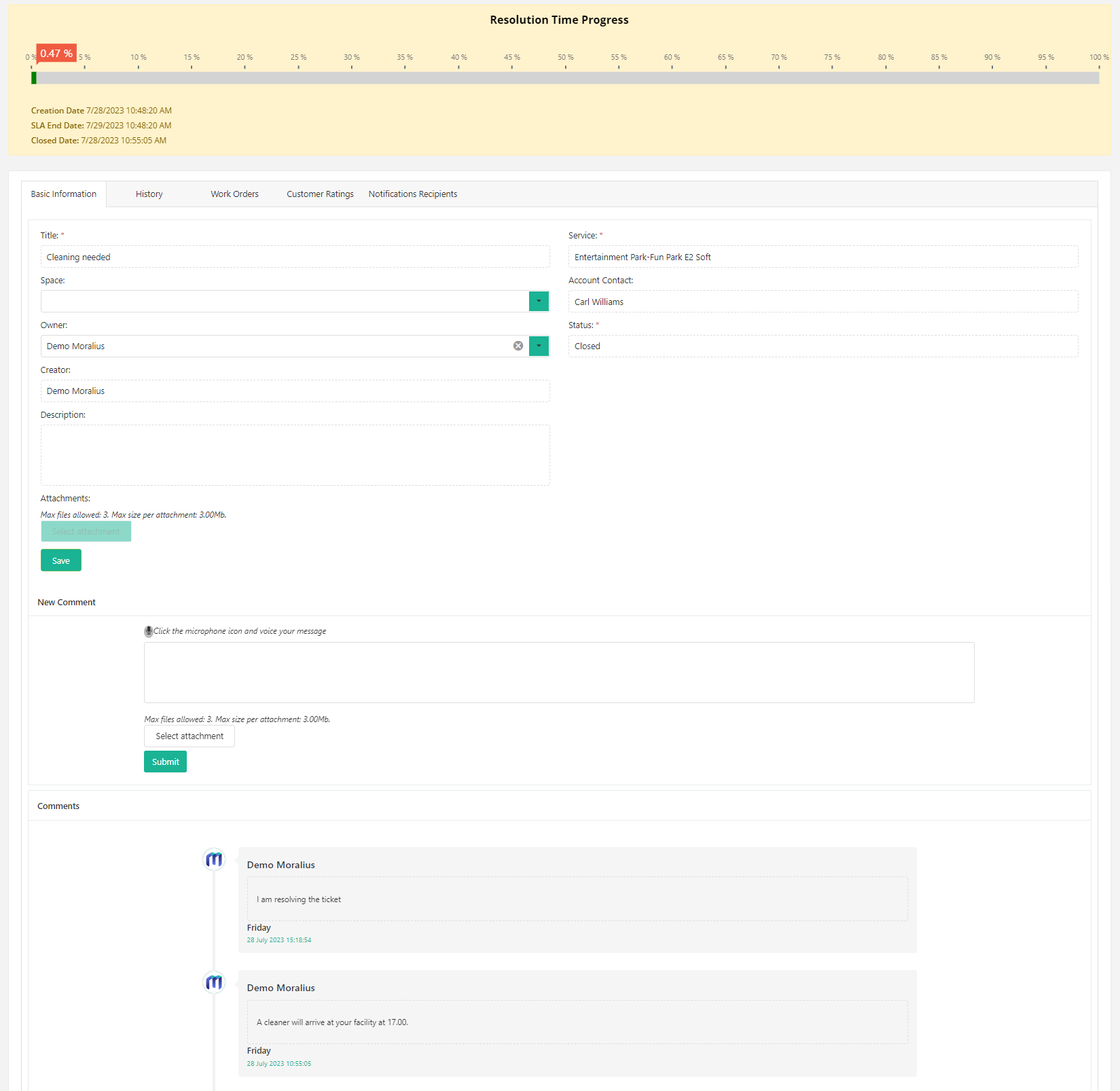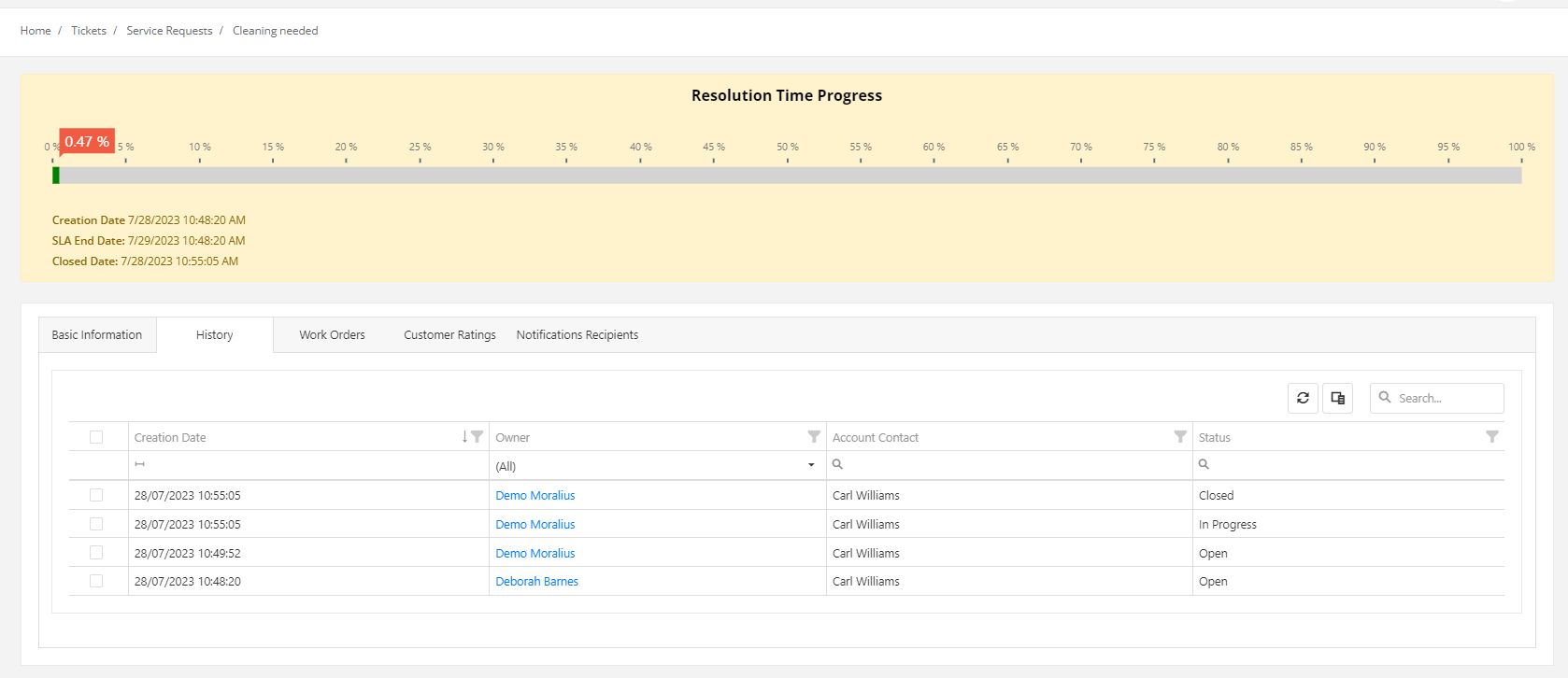This article will guide you on how to view or edit a service request in Moralius.
How to view/edit a service request
To view or edit a service request, simply follow the steps below:
- Click on ‘Tickets’ on the menu on the left part of the screen.
- Click on ‘Service Requests’.
- Select the service request you want to view or edit and click the pencil/eye icon (depending on your role permissions) at the right of the row.
- Change the fields that you want.
- Click on ‘Save’ if you want to save any changes.
Basic information
On the 'Basic information' tab you can view/edit the following fields:
- Title
The title of the ticket.
- Service
The service the ticket is linked to.
- Space
The space linked to the service.
- Account Contact
The full name of the account contact linked to the ticket.
- Owner
The full name of the owner of the ticket.
- Status
The status of the ticket.
- Creator
The full name of the creator of the ticket.
- Creation Date
The date the ticket was created.
- Description
A description of the ticket.
Also, on this screen, you can create a new work order. For more information on how to create a work order, read the section below (New Work Order).
Finally, on this screen, you can do the following:
- Download an attachment. To do this, click on the attached file name under 'Attachments'.
- Upload an attachment. To do this, click on 'Select attachment' and select the file you want to attach.
- Read any included comments in the 'Comments' section on the bottom part of the screen.
- Add a comment by typing text in the 'New Comment' section and then clicking on 'Submit'. You can also add an attachment to your comment by clicking on 'Select attachment' and selecting the file you want to attach.

- Resolve the ticket. To do this (you need to be the owner of the ticket), add a comment by typing text in the 'New Comment' section, tick the 'Resolved' box and then click on 'Submit'.

New Work Order
In order to create a work order from a service request that is not closed, click on the red 'New Work Order' button.
Then, to complete the work order creation, in the pop-up that appears, on the 'Basic Information' tab, follow the steps below:
- In the 'Title' field, type the title of the work order (by default copied from the service request title).
- In the 'Worker' field, select the worker that will be responsible for completing the work order.
- In the 'Implementation Date' field, select when you want the work order to be implemented. Depending on the worker you have selected:
- a green tick icon will appear in the box if the worker is available at the selected date & time.
- a red x icon will appear in the box if the worker is unavailable at the selected date & time.
- Only tick the 'Skipped' box, if you don't want the work order to be visible to the worker to whom it has been assigned and to the customer linked to the service.
- Click on 'Save'.

On the 'Assets' tab, before saving the work order from the 'Basic Information' tab, you can associate an asset to the work order, by following the steps below:
- Click on the + icon on the top-right part of the screen.
- On the pop-up screen that appears, select the asset that you want.

History
On the ‘History’ tab you can view the history log of the service request. The following fields are displayed:
- Creation Date
The creation date of the ticket.
- Owner
The full name of the owner of the ticket.
- Account Contact
The full name of the account contact linked to the ticket.
- Status
The status of the ticket.

Work Orders
On the ‘Work Orders’ tab you can view the work orders linked to this ticket. The following fields are displayed:
- Title
The title of the work order.
- Worker
The full name of the worker linked to the work order.
- Implementation Date
The implementation date of the work order.
- Status
The status of the work order.
- Active
Shows whether the work order is active or not.

Related articles
Read this article to see how you can filter and sort, or even select which columns will appear.